-
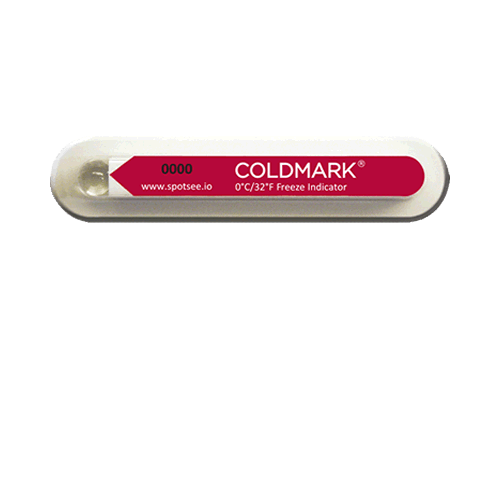
ColdMark
Read More >ColdMark descending temperature indicators are single-use devices that provide accurate, irreversible evidence of a below-temperature deviation.
The ColdMark turns from clear to violet when the temperature goes below a predetermined threshold.
-
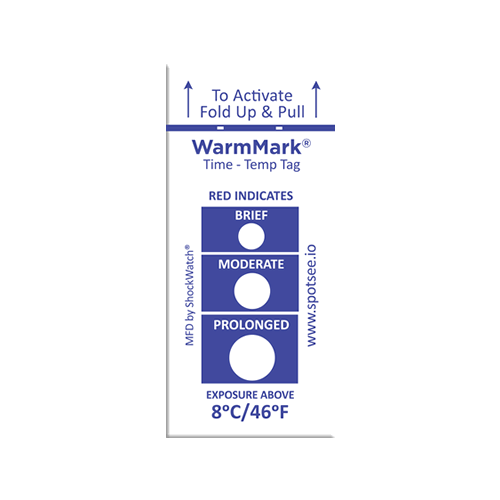
WarmMark
Read More >The WarmMark temperature sensors alert users of exposure to high temperature conditions. They also indicate the cumulative amount of time above the temperature threshold. Without a temperature indicator, a cold chain breach may go unnoticed resulting in a compromise in your product’s quality.
-
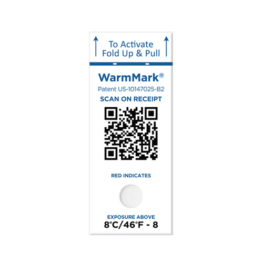
WarmMark QR
Read More >WarmMark QR is a single-use, battery free, connected time-temperature sensor enabled by smart phones to seamlessly determine if a condition (i.e. temperature) excursion has occurred and reports this condition along with time, date, location, and serial number to the SpotSee cloud.
-
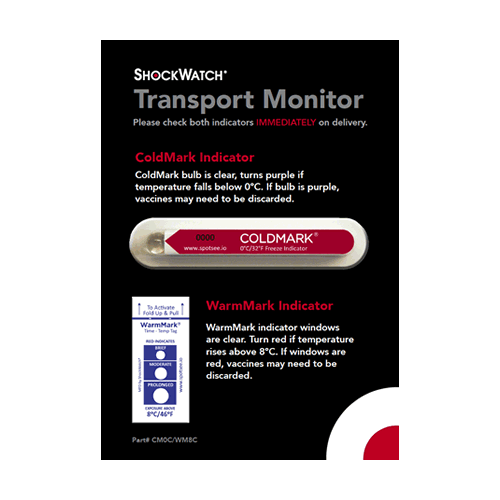
Cold Chain Transport Monitor
Read More >The Cold Chain Complete Transport Monitor is an all inclusive single-use, dual temperature indicator which alerts users of exposure to unacceptable temperature conditions.
-
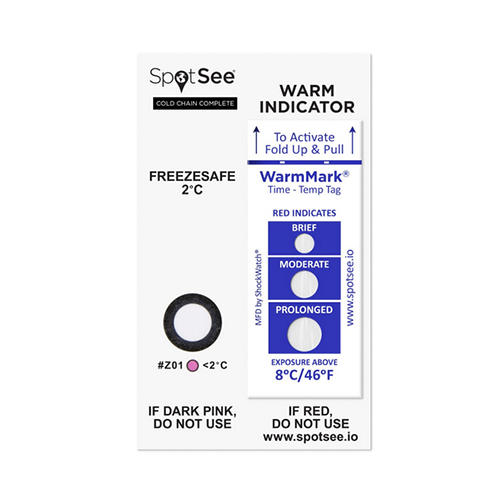
Cold Chain Complete
Read More >The Cold Chain Complete line of temperature indicators are the cost effective solution to monitor temperature sensitive products. They are a single-use visual indicator that provide accurate, irreversible evidence of a temperature excursion created to help our customers monitor for cold and hot temperature excursions. It is available in two formats: the standard ColdChain Complete and ColdChain Complete XS.
-
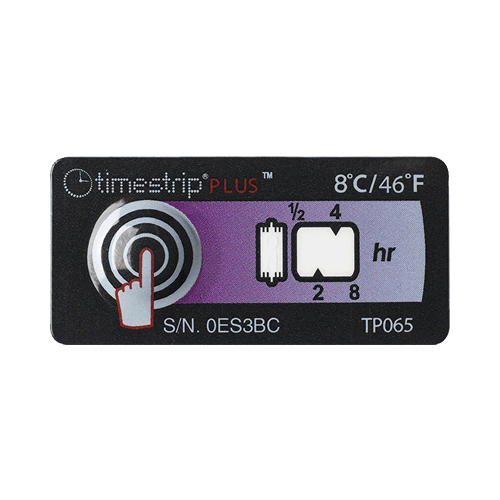
TimeStrip Plus Temperature Indicators
Read More >Timestrip® PLUS temperature indicators provide simple, quick and cost effective answers to your temperature sensitive products. They record elapsed time at or above a specified threshold temperature.
Timestrip® PLUS are small and self-adhesive so they can be attached directly to a product, package or shipment. -
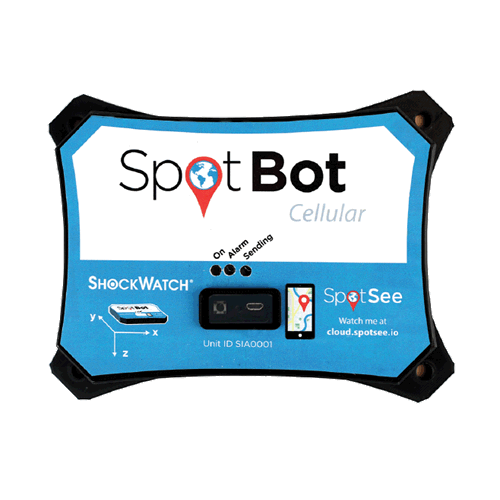
SpotBot Cellular impact monitoring and tracking recorder
Read More >SpotBot Cellular impact monitoring and tracking recorder is a standalone logistics and supply chain damage monitoring device that delivers tri-axial impact monitoring, remote temperature monitoring and live tracking through cellular connectivity.
It features real-time visualisation through the SpotSee web based platform. -
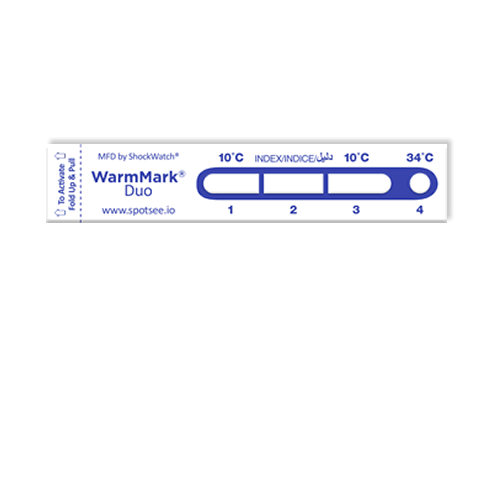
WarmMark Duo
Read More >The WarmMark Duo temperature indicator indicates the duration of temperature exposure at two different activation temperature levels, 10°C and 34°C in the one indicator.
-
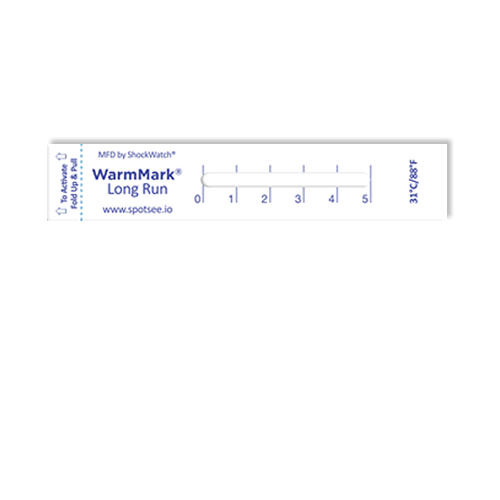
WarmMark Long Run
Read More >The WarmMark Long Run temperature indicator indicates a product’s long term exposure to temperature excursions above either 10°C or 31°C
-
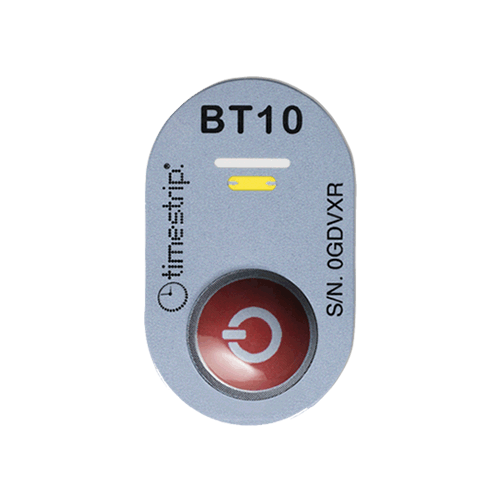
Blood Temp
Read More >The Blood Temp temperature indicators have been specifically designed to monitor the core temperature of a blood bag during blood transport. Helping to boost the efficiency of your blood transport system.
When the core temperature of the bag gets to either 6°C when in storage or 10°C when in transit, the breach window will turn from white to blue, letting you know the blood bag needs to be discarded.
Compliance: The Blood Temp 10°C meets all FDA and AABB requirements: FDA CFR 600. 1 5 (a) for monitoring blood temperature. FDA 510(k) #BK150289
-
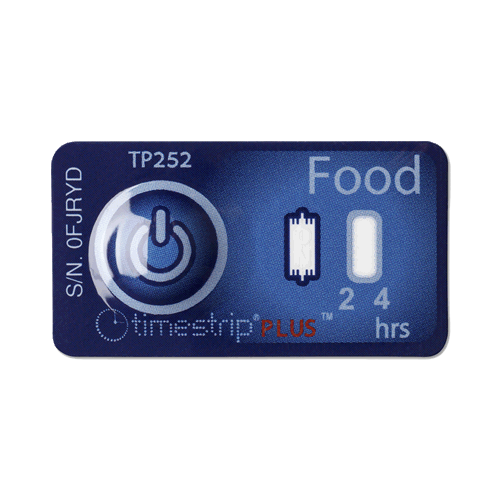
Timestrip Temperature Indicators for Food
Read More >Timestrip Food temperature indicators, for food temperature monitoring, make tracking temperature breaches across a multitude of cold chain food industry applications a simple, cost-effective process.
-
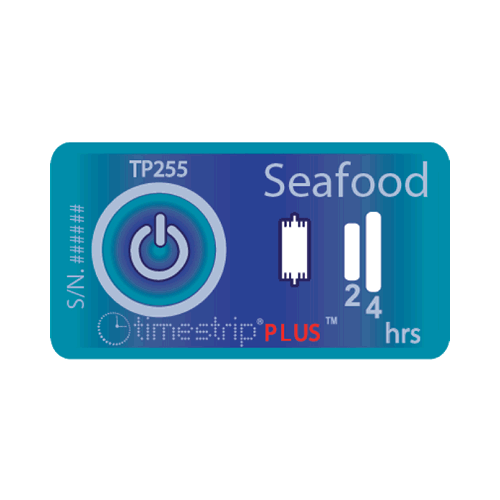
Seafood Indicator
Read More >The TimeStrip® Seafood Indicator is a simple solution that helps determine if your seafood shipments have been exposed to unacceptable temperature during transit.
Which is is the best temperature monitoring product for me?
The best indicators for your product will vary depending on several factors such as:
– Is the product sensitive to damage from cold, heat, or both?
– Does single exposure render the product improperly handled? Does the temperature need to remain above or below the threshold for a long period of time for damage to occur?
– Do you require a single-use Temperature Indicator (either compromised or not compromised)? Or a temperature recorder that captures data every minute? A temperature recorder can better tell you which stage in the supply chain has been compromised and for how long
– Single-use Temperature Indicators can be a more cost effective solution. This is especially true if you just need to know if the shipment has been compromised and not when.
– Do you have any special requirements for storing or transporting goods? These could include monitoring products in extreme environments such as low temperatures of -80 degrees C or being submerged in water?
Why should I use temperature Monitoring Devices even if I haven’t had issues?
Increased TGA regulations have been implemented on food products and other regulations on different products. It’s become increasingly essential to maintain the integrity of temperature sensitive products.
Having proper Continuous Digital Temperature Monitoring throughout every stage of the supply chain ensures the product arrives in perfect condition. It lets you find and address potential issues related to temperature regulation.
Unexpected delays at any stage of the supply chain can compromise product quality or safety. So too can neglect and improper transport or storage impact quality and safety. Constant monitoring with a PCTM Device allows you to ensure any delays or neglect have not compromised your product quality.
What equipment or software will I need to monitor temperature properly?
Our single use Temperature Monitoring Solutions do not require any special equipment, training or software to be used successfully. Our single or multi use recorders send data to included software. Data aligned with the correct product parameter setup for monitoring wireless temperature excursions is received by the software.
How easy is it to use Temperature Monitoring equipment?
All ShockWatch temperature sensors are easy to use and attach to your products. Most products only require single monitoring. Multiple monitors may be used for very large products or sensitive shipments.
Activation of the Temperature Monitoring Device is simple with the removal of a protective strip or by pushing a button. ShockWatch indicators are self adhesive and easy to attach to products or product packaging. Shockwatch temperature recorders are easily placed near the products being monitored and can be activated automatically or by pushing a button.
ShockWatch temperature monitors provide easy access to a safe and secure method of ensuring your shipment arrives in the proper fashion. Temperature sensing equipment works in real time and has a wide range of applications. With remote temperature monitoring, you gain access to real time monitoring of temperatures. This identifies when a cold chain breach may have occurred and will alert you by email or sms.
How accurate is the ShockWatch Temperature Monitoring system?
All ShockWatch temperature monitoring devices are highly accurate, ranging from 0.5°C to 2°C in accuracy. You can see the specific temperature accuracy for each specific product inside the product page.
What temperature ranges can I monitor?
You can use Shockwatch monitors to measure or indicate temperatures ranging from -80°C to +37°C.
TEMPERATURE MONITORING SYSTEMS FROM SHOCKWATCH
Globally, medical regulators are becoming attuned to cold chain issues. This is occurring as biologics, vaccines, and other temperature sensitive products are commercialised for a global clientele.
Many regulators now recommend including temperature monitoring technology in every cold chain shipment. Controlled temperature shipping is increasingly important in the food, chemical, and aerospace industries, too. It ensures that their products are handled at optimum temperatures to ensure they last as long as they should.
Documenting chain of custody for temperature sensitive products enhances regulatory assurance. It also alerts shippers to conditions affecting products’ shelf lives and efficacy. Knowing whether, when, and where temperature excursions occurred helps shippers ensure safe products. It therefore protects their clients as well as their own reputations.
Temperature monitoring also assigns accountability when excursions occur. Solutions include inexpensive indicators that alert shippers to mishandling. They also include sophisticated monitors that pinpoint when, where, and for how long excursions occurred. Companies, therefore, can match the technology to their needs.
What is the Cold Chain
It doesn’t matter whether a product is stored in a warehouse or in transit across the country or across the globe. If the temperature of the product must be controlled, that product is part of the cold chain.
Until recently, the term “cold chain” referred only to products that needed to be cooled. Now it has grown to also include products that must be kept at room temperature. As products that must be protected from the cold enter the mix, the term “cold chain” is morphing to “controlled temperature.”
Most temperature controlled products are shipped in the 2°- 8°C range. The second most popular temperature range for shipping is 15°-25°C – controlled room temperature (CRT). While generally, products requiring controlled room temperature are stable, regulators are increasingly asking for proof that temperatures were maintained.
The business case to deploy temperature monitors is compelling and their use is increasingly mandated by regulators throughout the world.
Seafood and medical goods are two obvious examples of products needing cold chain handling. However, the type of products requiring controlled temperatures is expanding dramatically. Chemical products (like paints and coatings), sometimes use temperature controlled shipping. This prevents them from separating so they will maintain consistency and, therefore, perform better.
Fruits and vegetables are another example of products requiring cold chain technology. Cooling them immediately after they are picked, extends their shelf life by several days. Even potatoes – a rugged crop – experience changes in sugar content based upon their storage temperatures.
To improve food safety and minimise recalls, temperature monitoring is one of the best things shippers can do. Temperature monitors, affixed internally or to packages’ exteriors, provide proof of the environmental temperatures sensitive goods experience. As they move throughout the supply chain, this is very important.
The highly regulated medical industry is experiencing very strict requirements. This has happened as health authorities throughout the world adjust their national medical good distribution practices. Insistence upon documentation proving proper temperatures have been maintained throughout shipping is now common. Without evidence that medical goods have been shipped and stored at proper temperatures, many nations will refuse to accept shipments.
Monitoring Options
A wide variety of monitoring technology is available. For example, indicators that change colour to flag temperatures that are too hot or too cold are an inexpensive solution. These devices can be packaged with items that need simple go/no go information.
Temperature recorders that provide detail about the length and extent of temperature excursions are a good solution for more nuanced products. This product functionality allows them to be diverted to closer markets or evaluated to determine their safety or effectiveness.
Temperatures are recorded at set intervals, enabling shippers to also know whether a package was opened. They also indicate when and where temperature excursions occurred.
Merely packing a product in ice and putting it on a plane is no longer good enough to satisfy regulators. Sensitive products demand temperature monitoring to prove to receivers, regulators, insurers and attorneys that they were transported at the proper temperatures. And, monitoring temperatures during shipment is just good business sense.
Companies do their utmost to ensure their products arrive in their most usable condition. If their products don’t, the company deserve answers. Temperature monitors can help provide those answers.
For more information about how temperature monitors can improve your cold chain shipments, contact us or call us on 1 300 074 625.

